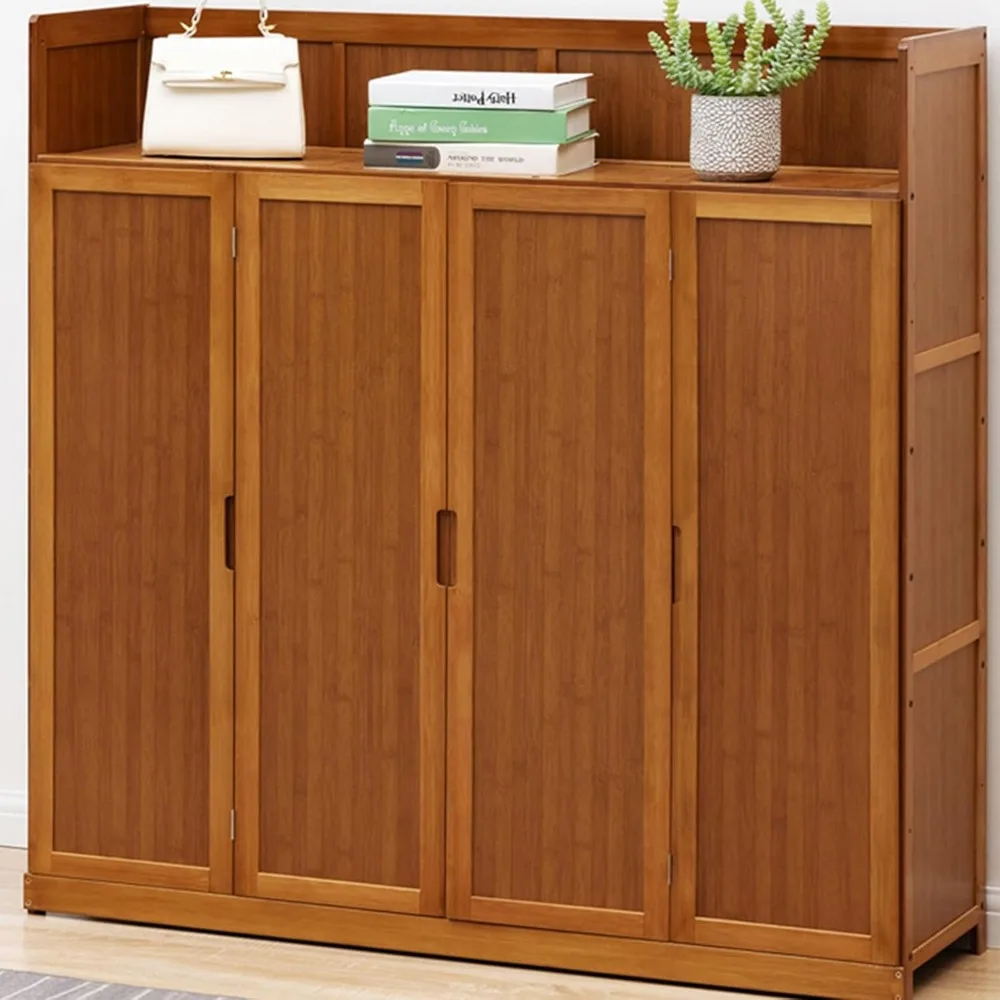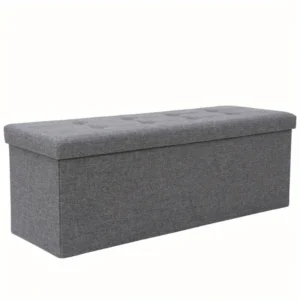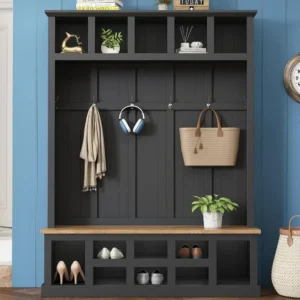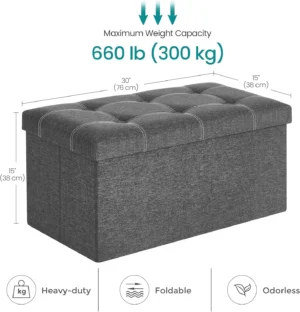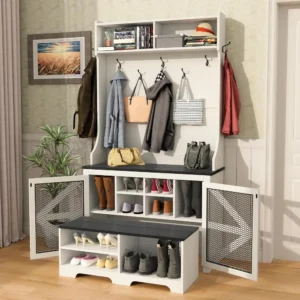Understanding Entryway Storage Options: Open and Closed Shelving Explained
Your entryway serves as both the first impression for guests and a functional space that you use daily. Having the right storage solution can make a world of difference in how this space looks and functions. When considering entryway storage, you’ll typically encounter two main options: open shelving and closed shelving.
Open shelving refers to exposed storage where all items remain visible. This includes:
– Floating shelves mounted directly to the wall
– Open cubbies for organizing shoes and accessories
– Bookcase-style units without doors
– Wall-mounted racks and hooks
Closed shelving, on the other hand, conceals your belongings behind doors, drawers, or lids:
– Cabinets with doors that hide contents
– Storage benches with lift-top compartments
– Console tables with drawers
– Closed cupboards and armoires
The fundamental purpose of entryway storage is threefold: to organize your essentials, provide easy accessibility to frequently used items, and enhance the aesthetic appeal of your home entrance. The choice between open and closed shelving can significantly impact how you achieve these goals.
Successful transform entryway space-saving benches provide both functionality and style, regardless of whether they feature open or closed storage components. Understanding the differences between these options will help you make an informed decision based on your specific needs and preferences.
For homes with limited space, entryway bench shelf storage options offer versatile solutions that can incorporate either open shelving, closed compartments, or a combination of both.
The Advantages of Open Shelving in Entryways
Open shelving in entryways offers several compelling benefits that make it a popular choice for many homeowners:
Immediate Accessibility
One of the greatest advantages of open shelving is the easy access it provides to frequently used items. When you’re rushing out the door, being able to grab your keys, mail, or bag without opening a drawer or cabinet door can save valuable time. This convenience factor makes open shelving particularly practical for busy households.
Visual Appeal and Display Opportunities
Open shelving transforms storage into a design feature by creating display opportunities for decorative items. You can showcase:
– Indoor plants to bring life to your entryway
– Decorative baskets or boxes
– Art objects and photo frames
– Books and magazines
– Seasonal decorations
Creates an Illusion of Space
In smaller entryways, open shelving can make the area feel more spacious and airy compared to bulkier closed storage units. The visual openness prevents the entry from feeling cramped or confined, which is especially beneficial in homes with limited square footage.
Budget-Friendly Options
Generally, open shelving tends to be more affordable than closed cabinetry since it requires fewer materials and less complex construction. This cost advantage allows you to allocate your budget to other aspects of your entryway design or to invest in higher-quality shelving materials.
Design Flexibility
Open shelving adapts easily to various home styles, from minimalist modern to rustic farmhouse. The versatility of open shelves means they can evolve with your changing tastes and home decor without requiring a complete overhaul of your storage system.
Encourages Organization
When everything is visible, there’s a natural incentive to keep items neat and organized. Many homeowners find that open shelving encourages them to be more thoughtful about what they place in their entryway and how they arrange these items.
For more inspiration on incorporating this storage style, modern open shelving entryways showcase how contemporary homes can maximize both function and style with exposed storage solutions.
Challenges of Open Entryway Shelving
While open shelving offers many benefits, it’s important to consider potential drawbacks before committing to this storage solution for your entryway:
Dust Accumulation
Without the protection of doors or drawers, open shelves collect dust more readily. This means more frequent cleaning is required to keep your entryway looking fresh and well-maintained. Depending on your home’s location and ventilation, you might find yourself dusting these surfaces several times a week.
Visual Clutter Potential
Open shelving puts everything on display—the good, the bad, and the cluttered. Without careful organization and regular maintenance, these shelves can quickly become eyesores. Mail, keys, gloves, hats, and other daily essentials can create a chaotic appearance if not consistently organized.
Everything Remains Visible
Not all entryway items are attractive enough to display. Practical necessities like umbrellas, pet leashes, or children’s outdoor gear might not contribute positively to your entryway aesthetic but are essential for daily life. With open shelving, these items remain in full view unless stored in decorative containers.
Visual Overwhelm
In busy households with multiple family members, open shelving can create visual overwhelm as everyone’s essentials compete for space. This is particularly true in smaller entryways where space is already at a premium.
Limited Privacy and Concealment
Some items are better kept private or concealed from view. With open shelving, there’s no way to hide valuables or items you’d prefer to keep discreet. Seasonal gear that’s not regularly used can also create unnecessary visual clutter when stored on open shelves.
Styling Pressure
Open shelving creates an ongoing responsibility to maintain an attractive display. This “styling pressure” can feel burdensome for some homeowners who prefer low-maintenance solutions or who don’t enjoy regularly rearranging decorative elements.
For those struggling with limited space, learning how to organize small entryway bench areas can help mitigate some of these challenges through smart organizational strategies and thoughtful item selection.
Benefits of Closed Shelving Solutions for Entryways
Closed storage options offer distinct advantages that make them ideal for many entryway situations:
Superior Clutter Control
Perhaps the most significant benefit of closed shelving is its ability to hide clutter behind doors, drawers, or lids. This concealment allows you to store a variety of items—regardless of their appearance—while maintaining a clean, organized look in your entryway. Even on hectic days when perfect organization isn’t possible, closed storage keeps the visual chaos contained.
Protection from Dust
Items stored behind doors or in drawers remain significantly cleaner than those on open shelves. This protection reduces the frequency of cleaning required and helps preserve your belongings from dust accumulation, especially important for textiles like scarves, hats, and gloves.
Clean, Streamlined Aesthetic
Closed storage creates a more minimalist, cohesive look regardless of what’s stored inside. This streamlined appearance can make your entryway feel more spacious and intentionally designed, creating a calming first impression for both residents and guests.
Security for Valuables
Closed storage provides a greater sense of security for items you’d prefer to keep private or protected. While not necessarily secure in the sense of being lockable (though some units offer this feature), closed storage keeps valuables out of immediate sight from casual visitors.
Versatility for Various Item Types
The interior of closed storage units can accommodate a wide range of item sizes and types. From bulky winter boots to tiny keys, closed storage can be customized with dividers, hooks, and other organizational tools to maximize efficiency without compromising the external appearance.
Multi-Functionality
Many closed storage solutions serve dual purposes—for example, storage benches provide both seating and storage space, making them excellent space-saving options for smaller entryways. This multi-functionality adds value beyond simple storage.
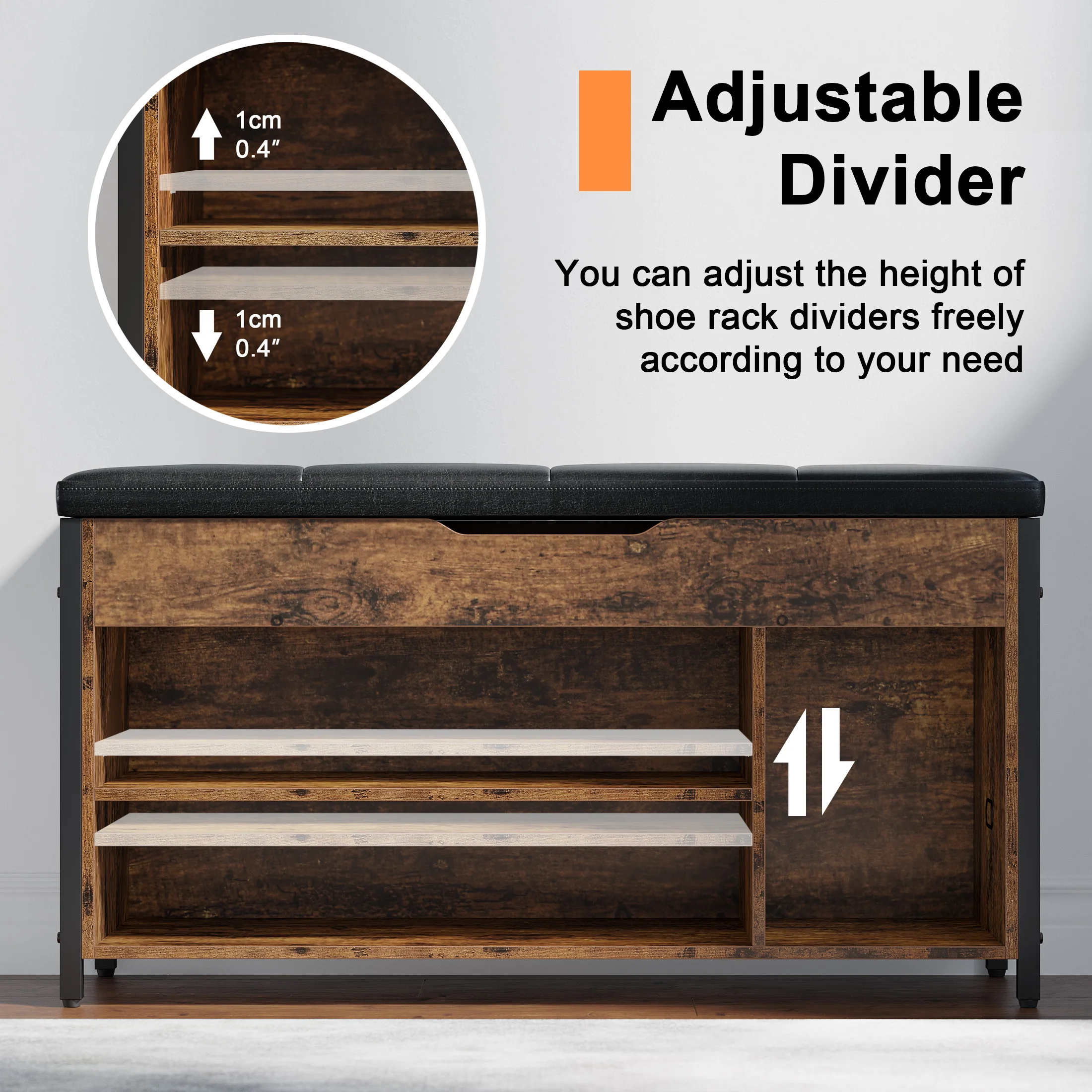
Environmental Protection
Closed storage offers better protection from environmental factors like direct sunlight (which can fade fabrics), moisture, and temperature fluctuations, helping to extend the life of stored items.
For those interested in exploring closed storage options, our collection of entryway bench storage solutions offers various styles that combine practical storage with attractive design elements to enhance your home’s entrance.
Drawbacks of Closed Entryway Storage
While closed storage offers many advantages, it’s important to consider these potential downsides before deciding:
Reduced Accessibility
Closed storage requires additional steps to access your belongings. Opening doors, pulling out drawers, or lifting lids takes more time and effort compared to simply grabbing items from an open shelf. This reduced accessibility can be inconvenient during busy mornings or when entering with arms full of groceries or packages.
Hidden Disorganization
The “out of sight, out of mind” principle can lead to disorganized interiors within closed storage units. Without the visual reminder to maintain order, drawers and cabinets can quickly become cluttered dumping grounds for miscellaneous items, making it difficult to find what you need when you need it.
Bulkier Appearance
Closed storage units typically have a more substantial visual weight and physical footprint than open shelving options. This bulkiness can overwhelm smaller entryways or narrow hallways, making the space feel cramped or congested. The solid facades of closed units can also make a space feel more enclosed and potentially darker.
Higher Cost
Generally, closed storage comes with a higher price tag due to more complex construction, additional materials for doors and drawers, and hardware components like hinges and handles. This cost difference can be significant, especially for higher-quality pieces designed to withstand frequent use.
More Challenging Installation
Closed storage units are often heavier and more complex to assemble or install compared to simple open shelving. They may require professional installation in some cases, adding to the overall cost and complexity of the project.
Limited Display Opportunities
With closed storage, you lose the ability to showcase decorative items or create visual interest through displayed objects. This limitation can result in a more utilitarian appearance unless you incorporate additional decorative elements elsewhere in your entryway.
For those dealing with space constraints, exploring space-saving entryway ideas can help you identify closed storage solutions that minimize these drawbacks while maximizing functionality in compact areas.
Key Decision Factors: How to Choose Between Open and Closed Entryway Storage
Making the right choice between open and closed storage depends on several factors specific to your home and lifestyle:
Space Considerations
The physical dimensions of your entryway should significantly influence your storage choice:
– Narrow or small entryways may benefit from open shelving’s lighter visual presence
– Deeper spaces can accommodate more substantial closed storage units
– Consider traffic flow patterns—storage shouldn’t impede movement through the space
– Ceiling height may dictate vertical storage options versus lower, horizontal solutions
Household Composition
Who lives in your home plays a crucial role in determining the ideal storage solution:
– Families with young children might prefer closed storage to conceal clutter and prevent little hands from accessing certain items
– Pet owners may benefit from closed storage to protect belongings from fur, dirt, or curious pets
– Single adults or couples without children might enjoy the styling opportunities of open shelving
– Multi-generational households may need varied storage options to accommodate different needs and heights
Aesthetic Preferences
Your personal style and overall home design should harmonize with your entryway storage:
– Modern and minimalist designs often pair well with sleek, closed storage for a clean look
– Farmhouse or rustic styles might showcase more character through open shelving with decorative elements
– Traditional homes typically benefit from classic closed cabinetry that complements architectural details
– Eclectic or bohemian styles can incorporate a mix of both storage types for visual interest
Lifestyle Factors
Your daily routines and activities significantly impact which storage type will serve you best:
– Active households with sports equipment and outdoor gear may need more robust closed storage
– Those who entertain frequently might prefer the accessibility of open shelving for guest items
– Work-from-home professionals could benefit from designated closed storage for mail and documents
– Frequent travelers might appreciate open shelving for quickly grabbing essentials on the go
Seasonal Considerations
Climate and seasonal changes affect what needs to be stored in your entryway:
– Regions with distinct seasons require adaptable storage for rotating seasonal items
– Rainy climates benefit from closed storage for wet umbrellas and raincoats
– Snowy areas need robust solutions for boots, heavy coats, and winter accessories
Organization Tendencies
Be honest about your organizational habits:
– If you naturally maintain order, open shelving can showcase your organizational skills
– If you prefer to hide clutter quickly, closed storage offers a more forgiving solution
– Consider how much time you’re willing to dedicate to maintaining the space
For specialized solutions that address specific storage needs, exploring our collection of shoe storage bench entryway options can help you find the perfect balance between function and style.
The Hybrid Approach: Combining Open and Closed Storage for Optimal Functionality
Often, the best solution isn’t choosing between open and closed storage but thoughtfully combining both options to maximize the benefits of each while minimizing their drawbacks.
Benefits of the Hybrid Approach
A mixed storage strategy allows you to:
– Showcase decorative items on open shelves while concealing practical necessities behind closed doors
– Create visual interest through varying storage types while maintaining overall organization
– Tailor storage solutions to specific items based on frequency of use and aesthetic appeal
– Adapt to changing needs without overhauling your entire entryway storage system
Strategic Item Placement
Consider which items belong in each type of storage:
Best for Open Storage:
– Decorative items and plants
– Frequently accessed essentials like keys and sunglasses
– Beautiful baskets that can contain smaller items
– Books, magazines, or mail that needs immediate attention
– Attractive shoes or boots that complement your decor
Best for Closed Storage:
– Seasonal items not currently in heavy rotation
– Private documents and valuables
– Mismatched or utilitarian items (extra umbrellas, pet supplies)
– Bulky items that would create visual clutter
– Shoes and accessories that don’t enhance your decor
Design Harmony
To create a cohesive look with mixed storage types:
– Use consistent materials, colors, or finishes across both open and closed elements
– Maintain similar proportions and visual weight between different storage components
– Create intentional zones that serve specific functions within your entryway
– Use complementary hardware and accessories throughout the space
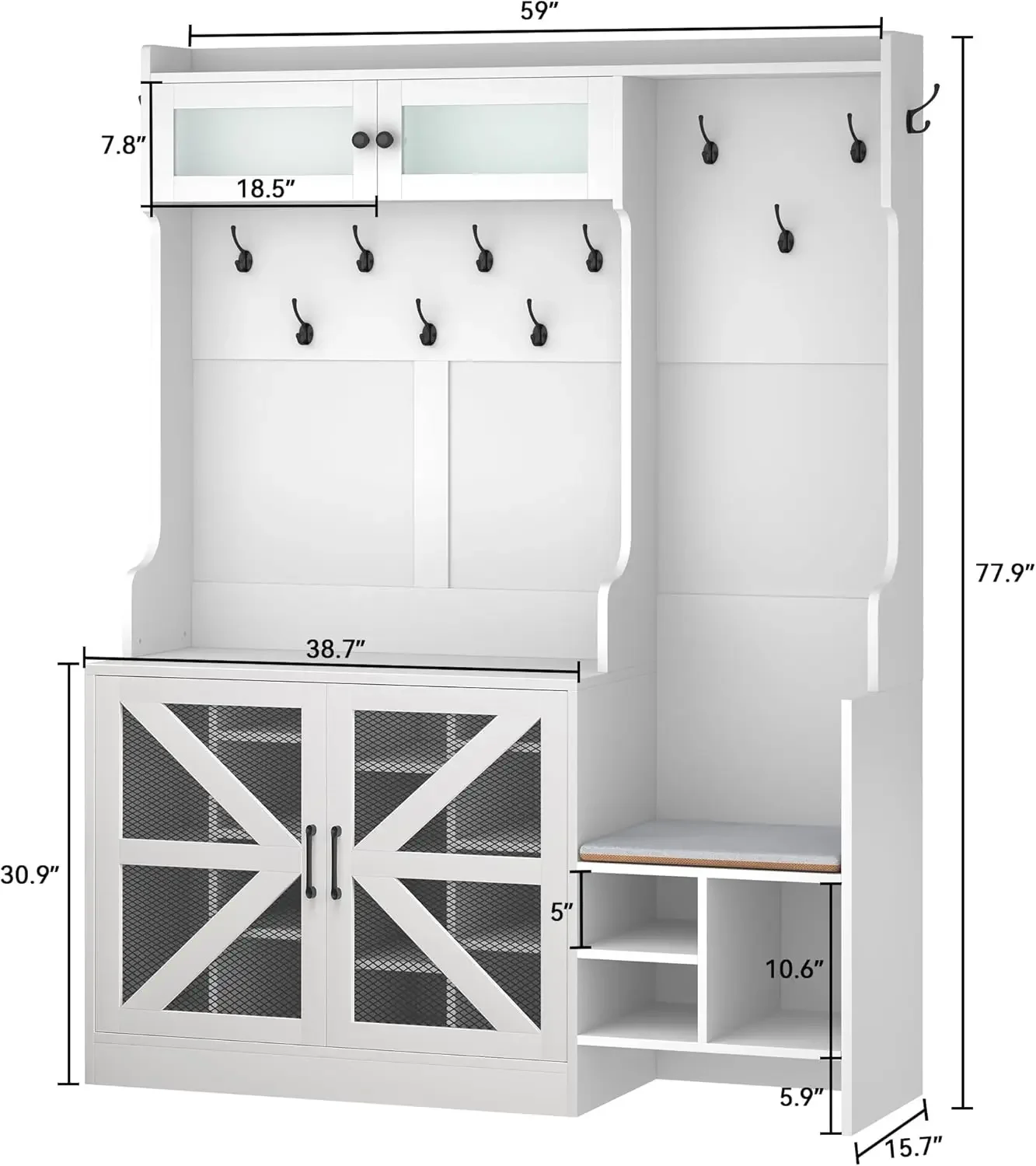
Flexible Configuration Options
Consider these hybrid solutions for different entryway layouts:
– Wall-mounted cabinets above open shoe benches
– Hall trees with hooks, open shelves, and closed cabinets
– Console tables with both open display areas and closed drawers
– Built-in units with varying compartment types
– Modular systems that can be reconfigured as needs change
For more creative ways to blend different storage styles, exploring hallway furniture storage style options can provide inspiration for creating a personalized hybrid solution that perfectly suits your home.
Smart Organization Strategies for Any Entryway Storage System
Regardless of whether you choose open shelving, closed storage, or a hybrid approach, implementing these organization strategies will help maximize functionality:
1. Utilize Containers and Dividers
– Use baskets, boxes, and bins to group similar items together
– Select containers that complement your decor while providing practical divisions
– Label closed containers in closed storage for easy identification
– Choose transparent containers for closed storage to see contents at a glance
2. Create Designated Zones
– Establish specific areas for different categories of items
– Keep frequently used essentials at eye level or in the most accessible spots
– Store seasonal or occasional items in less prime real estate
– Designate a drop zone for mail, packages, and items needing attention
3. Implement Smart Systems
– Install hooks at appropriate heights for different family members
– Use drawer dividers to maintain organization in closed storage
– Add small trays or dishes for tiny items like keys and coins
– Consider shoe racks or cubbies sized appropriately for your household’s footwear
4. Maintain Through Seasonal Rotation
– Schedule quarterly reviews of entryway contents
– Rotate seasonal items to front/accessible locations as needed
– Store off-season items in less accessible areas or elsewhere in the home
– Regularly purge items that no longer serve a purpose
5. Establish Daily Reset Routines
– Take 5 minutes each evening to return items to their proper places
– Involve all household members in maintaining organization
– Address clutter immediately rather than allowing it to accumulate
– Keep a small donation bag or box nearby for items that no longer serve you
For those working with limited space, best small benches entryways can provide compact but efficient storage solutions that incorporate these organizational principles without overwhelming your entrance area.
Style Guide: Designing Attractive Entryway Shelving
Creating an entryway that’s both functional and beautiful requires attention to design details, regardless of which storage type you choose:
Key Design Principles
– Balance visual weight with negative space to prevent a cluttered appearance
– Create rhythm through repetition of shapes, colors, or materials
– Establish proportion appropriate to your entryway’s dimensions
– Use contrast to create visual interest and highlight important elements
– Ensure unity by connecting your entryway design to adjacent rooms
Style-Specific Recommendations
Modern & Minimalist:
– Choose clean lines and simple shapes
– Limit color palette to neutrals with perhaps one accent color
– Emphasize function with minimal decoration
– Select storage with hidden hardware and smooth surfaces
– For open shelving, maintain significant negative space
Traditional & Classic:
– Incorporate rich woods and traditional profiles
– Choose symmetrical arrangements when possible
– Add molding or decorative details to closed storage
– Select hardware with timeless appeal (brass, bronze, nickel)
– Balance functionality with appropriate decorative elements
Farmhouse & Rustic:
– Embrace natural materials like reclaimed wood
– Incorporate texture through baskets, textiles, and mixed materials
– Choose storage with visible joinery or hardware
– Display vintage items or natural elements
– Blend practicality with casual, lived-in charm
Contemporary & Transitional:
– Mix materials like wood, metal, and glass
– Choose storage with interesting but not ornate details
– Balance straight lines with occasional curves
– Incorporate both open and closed elements
– Use texture more than pattern for visual interest
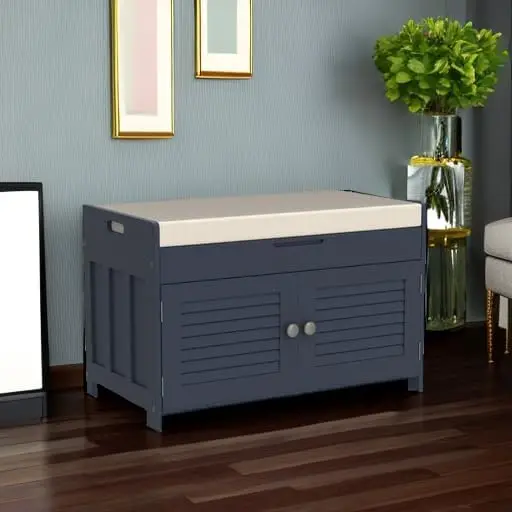
Color Considerations
– Choose colors that complement adjacent rooms for visual flow
– Consider light colors for small spaces to enhance brightness
– Use contrasting colors to highlight architectural features
– Remember that darker colors on storage units create a stronger visual presence
– When in doubt, neutral colors provide longevity and versatility
Shoe Storage Bench for Entryway
$459.02 Select options This product has multiple variants. The options may be chosen on the product pageEntryway Bench with Shelf Storage, Shoe Bench for Entryway, Shoe Storage Bench
$194.08 Select options This product has multiple variants. The options may be chosen on the product pageBench with Hooks and Storage, Entryway Hall Tree, Mudroom Bench with Cubbies, Mudroom Bench with Shoe Storage
$818.38 Select options This product has multiple variants. The options may be chosen on the product pageEntryway Coat Rack Bench, Entryway Hall Tree, Farmhouse Mudroom Bench, Mudroom Bench with Shoe Storage
$805.09 Select options This product has multiple variants. The options may be chosen on the product pageEntryway Bench with Shelf Storage, Small Shoe Bench
$151.16 Select options This product has multiple variants. The options may be chosen on the product pageBench with Hooks and Storage, Entryway Coat Rack Bench, Entryway Hall Tree, Mudroom Bench with Shoe Storage, Mudroom Coat Rack Bench
$793.73 Select options This product has multiple variants. The options may be chosen on the product page
For additional insights on designing different entry spaces, understanding the differences between mudroom storage vs entryway can help you determine appropriate styling approaches for each area’s unique needs and functions.
Questions to Consider: Is Open or Closed Storage Right for Your Entryway?
To determine which storage solution best suits your needs, ask yourself these key questions:
What is your primary storage need?
Consider whether you primarily need to organize, display, or conceal items. If you have beautiful accessories you want to showcase, open shelving might be ideal. If your priority is hiding clutter, closed storage will serve you better.
How much time can you dedicate to maintenance?
Open shelving requires more frequent dusting and mindful arrangement. If you prefer low-maintenance solutions or have limited time for cleaning, closed storage might be more practical for your lifestyle.
What’s your typical clutter threshold and organization style?
Be honest about your organizational habits. Do you naturally keep things tidy, or do you prefer to quickly hide mess? Open shelving works best for those who consistently maintain order, while closed storage forgives occasional disorganization.
Which items do you access most frequently in your entryway?
Items you use daily should be the most accessible. Consider whether these items are attractive enough for display on open shelving or would better serve your aesthetic goals behind closed doors.
Does your entryway receive direct sunlight or heavy foot traffic?
Environmental factors affect both your storage needs and the wear on your furniture. Closed storage better protects items from sunlight exposure and dust from high-traffic areas.
Our collection of entryway hall tree options offers versatile solutions that can help you address these considerations with storage that combines both open and closed elements for maximum functionality.
When to Choose Open Shelving: Ideal Scenarios
Open shelving is particularly well-suited for certain situations and household types:
- Small or narrow entryways where bulkier closed storage would overwhelm the space
- Homes with minimal entryway clutter or where residents consistently maintain organization
- Spaces that would benefit from the visual expansion that open shelving provides
- Design-focused households wanting to showcase decorative items or create visual interest
- Entryways that serve as transitional design elements between rooms with open concepts
- Situations where budget constraints make more affordable open shelving options attractive
- Households prioritizing quick access to frequently used items
- Homes with modern, minimalist, or contemporary design styles that emphasize clean lines
For these scenarios, open shelving provides both practical storage and enhances the overall aesthetic of your entryway, creating a welcoming first impression for your home.
Is Closed Storage Better For Your Entryway? Key Indicators
Closed storage might be the better option for your entryway if these scenarios sound familiar:
- Households with children or pets where controlling access to certain items is important
- Entryways that collect numerous items from multiple family members
- Homes in dusty environments or high-pollution areas where protecting belongings is a priority
- People who prefer a clean, minimal aesthetic regardless of what’s being stored
- Situations requiring storage of seasonal items that aren’t currently in use but need to be accessible
- Privacy concerns about displaying valuable items in an area visible from outside
- Homes with traditional, transitional, or formal design styles
- Households where quick cleanup before guests arrive is a regular necessity
In these cases, closed storage provides practical solutions while maintaining an organized appearance, even when what’s inside might not be perfectly arranged.
What About Budget? Cost Considerations for Entryway Storage
Budget often plays a significant role in choosing between open and closed storage options:
General Price Comparisons
– Open shelving typically costs 30-50% less than comparable closed storage units
– DIY open shelving can be created for as little as $50-100 for basic materials
– Quality closed storage benches generally start around $150-200 and can exceed $500
– Custom built-in solutions for either type will represent the highest investment
Budget-Friendly Alternatives
– Repurpose existing furniture like bookshelves or dressers for entryway storage
– Start with basic open shelving and add decorative bins or baskets to conceal items
– Look for modular systems that allow you to add components over time as budget allows
– Consider secondhand or vintage pieces that can be refinished to suit your style
– Mix DIY elements with purchased components for a custom look at lower cost
Investment Perspective
– Well-constructed closed storage typically offers greater durability for high-traffic areas
– Quality hardware on closed storage ensures doors and drawers continue functioning properly
– Consider cost-per-use for items that will serve multiple functions (like bench seating plus storage)
– Evaluate how storage solutions might affect home value—built-ins often provide good return on investment
When evaluating budget options, remember that storage needs evolve over time. Investing in adaptable solutions that can grow with your household often provides better long-term value than the least expensive option.
Conclusion: Creating Your Ideal Entryway Storage Solution
The choice between open and closed shelving for your entryway ultimately depends on your specific needs, lifestyle, and design preferences. Open shelving offers accessibility, visual spaciousness, and display opportunities but requires more maintenance and consistent organization. Closed storage provides clutter control, protection for your belongings, and a streamlined appearance but may take up more visual space and limit quick access.
Many homeowners find that a thoughtful combination of both storage types creates the most functional and attractive solution. This hybrid approach allows you to showcase select items while concealing others, giving you the best of both worlds.
Remember that your entryway storage serves both practical necessity and design opportunity. The right solution will not only keep your space organized but also set the tone for your entire home, creating a welcoming first impression for guests and a functional transition zone for residents.
By carefully considering the factors we’ve discussed—from space constraints to lifestyle needs to aesthetic preferences—you can create an entryway that beautifully balances form and function with storage that truly works for your household.

